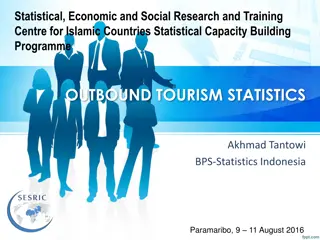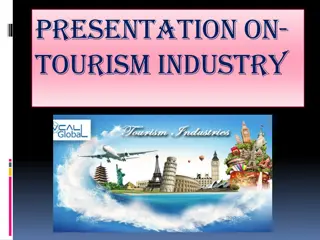Understanding Consumer Behavior in Tourism: Insights and Perspectives
Explore the complexities of consumer behavior in the tourism sector through key touchpoints, decision-making processes, cognitive approaches, and the influence of reference groups. The book delves into the dynamic journey from need to fully-formed tourism experiences, emphasizing the role of technology and virtual reference groups in shaping consumer interactions and choices.
Download Presentation

Please find below an Image/Link to download the presentation.
The content on the website is provided AS IS for your information and personal use only. It may not be sold, licensed, or shared on other websites without obtaining consent from the author. Download presentation by click this link. If you encounter any issues during the download, it is possible that the publisher has removed the file from their server.
E N D
Presentation Transcript
3rd Edition Strategic Management In Tourism Edited by LUIZ MOUTINHO AND ALFONSO VARGAS S NCHEZ
CHAPTER 5 CONSUMER BEHAVIOUR IN TOURISM RONNIE BALLANTYNE, LUIZ MOUTINHO AND SHIRLEY RATE
LEARNING OBJECTIVES To explore the nature of consumer behaviour within the tourism arena. Identify and discuss key internal and external facets that influence consumer decision making. Explore and illuminate the nature of consumer decision making processes.
1 UNDERSTANDING CONSUMER BEHAVIOUR IN TOURISM If one is to develop Tourism Marketing with Magnetism, consider right product, right place, right time with right technology, we must isolate and understand the key touchpoints or sweet spots that consumers desire in their unique decision making journeys. Understanding and predicting consumer behaviour is a central issue to marketing practitioners within the tourism arena.
2 DEFINING CONSUMER BEHAVIOUR IN TOURISM Consumer behaviour can easily be conceptualized as the process of acquiring and organizing information in the direction of a purchase decision. That said, it is not easy to fully address the question Why do people travel? The dynamic process of moving from need, to want, to desire and, ultimately, to demanding fully formed tourism experiences, is relatively complex.
3 THE COGNITIVE APPROACH This process typically encompasses the stages of searching for, purchasing, using, evaluating and disposing of products and services. This paradigm follows a cognitive approach and maps a cycle from stimulation, including motivation and intention formulation, actual behaviour and experience, evaluation and retention of consequences.
4 REFERENCE GROUPS People turn to particular groups for their standards of judgement. Human beings tend to make sense of reality by looking towards others behaviour. Any person or group real or imaginary that serves as a point of reference for an individual is said to stand as a reference group. It exerts a key influence on the individual s beliefs, attitudes and choices.
5 VIRTUAL REFERENCE GROUPS Technology has dramatically changed the way in which consumers now interact with each other and businesses (as well as the aforementioned traditional modes of reference group we are now in the age of the virtual reference groups), the rise of social networking and consumer blogging literally gives the user unlimited access and exposure to other trusted opinions, views and attitudes to every manner of products and services available.
6 SELF-IMAGE Purchase intentions relating to some products tend to be correlated and demonstrate congruence with self-image, while those relating to other products are correlated with the ideal self-image.
7 PERCEPTION AND COGNITION Perception is the process by which an individual selects, organizes and interprets stimuli in a meaningful and coherent way. A stimulus is any unit of input affecting any of the senses. Perceiving stimuli involves exposure, reception and assimilation of information.
8 MOTIVATION Motivation refers to a state of need, a condition that exerts a push on the individual towards certain types of action that are seen as likely to bring satisfaction. Vacation tourist motivation is greatly determined by social factors and is related to the need for optimal arousal. We have a need for stability as well as for novelty. In the case of travelling there are usually multiple motives, based on the tourist s expectations of what will be gained from the purchase.
ATTITUDE 9 An attitude is a predisposition, created by learning and experience, to respond in a consistent way towards an object, such as a product. This predisposition can be favourable or unfavourable. Attitudes are generally considered to have three components: cognitive, affective and conative.
INTENTION 10 Intention indicates the likelihood of purchasing a tourist product; it is the readiness-to-buy concept. Behavioural intention is said to be a function of: (i) evaluative beliefs towards the tourist product; (ii) social factors which tend to provide a set of normative beliefs for the tourist; and (iii) situational factors than can be anticipated at the time of the vacation plan or commitment.
11 DECISION-MAKING PROCESS Most models deal with five different steps in the decision process: (i) problem identification; (ii) information search; (iii) evaluation of alternatives; (iv) choice; and (v) post-choice.
12 THE EVOKED SET As consumers are increasingly pressured in terms of time and the number of choice alternatives that now exist, they have developed decision-making heuristics that act as short cuts in order to simplify the decision-making process. Sophisticated phased or funnel decision-making methods have emerged where consumers screen out unacceptable choice alternatives, preserving decision-making energy and time to evaluate between a smaller reduced subset of brands; this is commonly referred to as the choice set or evoked set .
13 THE NEW CONSUMER JOURNEY With the majority of consumers now beginning their journey on-line, and on mobile devices more and more attention is being placed on blended content. Getting the right balance with content both user generated and curated is and will continue to be a dominant theme. Content must Inspire and Help; it must be Authentic and Trustworthy and it must be evergreen content must be reviewed and updated 365 days a year. This is necessary to build Authority so as to encourage the transformation from prospect to consumer.























